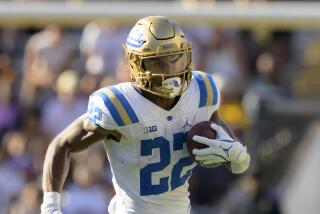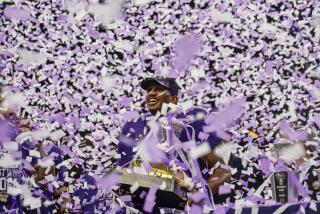COLLEGE FOOTBALL : By the Book, Defense Always Goes for Two
- Share via
It doesn’t happen often, but when it does it comes as a surprise to fans--and, in some cases, officials.
The reference is to a two-year-old college football rule that enables for the defense to score two points on a blocked extra point kick, or an interception from a two-point attempt.
In a nonconference game Oct. 21 between Millsaps, a Division II NCAA school from Jackson, Miss., and Union College of Barbourville, Ky., a member of the National Assn. of Intercollegiate Athletics, the rule was mistakenly interpreted by the officials.
Late in the game, Millsaps scored a touchdown, taking a 22-20 lead. The extra point kick was blocked and a Union defensive back scooped up the ball and ran 98 yards to the end zone.
Union, however, was credited with only one point instead of two. Officials concluded that a defensive conversion was worth only one point on a one-point try, and two on a two-point attempt.
Not so, according to the rule.
“All six officials were ignorant of the rule,” said Dave Schmotzer, Union’s athletic director. “The end result should have been a tie game at 22-22.”
Instead, the score was officially recorded as a 22-21 victory for Millsaps.
Schmotzer said that Union has received a favorable ruling from its own conference, the Mid-South.
“But, heck, neither of us is going to the Bluebonnet Bowl this year, hence they’re (Millsaps) counting it as a victory, but we’re listing it as a tie. It is not a judgment call. It’s a rule,” Schmotzer said.
James Van Valkenburg, director of statistics for the NCAA, agrees with Schmotzer. He also said that a defensive two-pointer is a rare occurrence.
“It is especially rare in Division I-A and I-AA,” he said. “The farther down you go (Division II and III) there is less skill and perfection.”
He cited some statistics:
Last year, there were only 14 two-point scores from blocked extra points through 2,743 games in all of the divisions, with Division III accounting for eight of them.
There were only six resulting from an interception, a pass, or a fumble, and none in Division I-A.
The numbers are up this year, 24 total two-point defensive scores.
“There are probably more, but we don’t always get results from Division II or III schools right away,” Van Valkenburg said.
One of these days, though, it will happen in a big game and hopefully the officials will be more knowledgeable than the six who worked the Millsaps-Union game.
Oregon Coach Rich Brooks remembers when there was a definite division of the haves and have-nots in the Pacific 10 Conference.
“We were one of the awful teams and so was Oregon State,” Brooks said. “But there isn’t a bad team in the conference now.”
With the exception of USC, which hasn’t lost a conference game, the other schools are beating each other regularly.
California upset Arizona last weekend, and Stanford upset Oregon earlier in the season when the Ducks were coming off a 44-6 rout of Iowa--and so it goes.
Such parity to an extent won’t help the Pac-10, though, in getting bowl bids.
It’s likely that only three Pac-10 schools, USC, Washington State, and one of the Arizona schools, will play in bowl games.
Brooks believes that his Ducks, who are 5-4 overall, have a shot at a bowl bid if they win their remaining games, against UCLA Saturday and Oregon State Nov. 18.
“That won’t be easy,” he said. “However, if we’re fortunate to win, the worst we could do is tie for third in the conference and it’s possible that we could tie for second.
“What has happened is that the bottom of the league has come up, which makes the top look a little weaker because the top teams get knocked off occasionally.”
Brooks added, however, that USC is clearly a notch above the other teams in the league.
“USC’s defense is stifling. That’s their edge,” he said. “Their offense is good, but not that much better than anyone else in the league.”
Oregon is the only conference school to have beaten USC since Larry Smith became the Trojan coach in 1987.
Question: Excluding World War II-shortened schedules, how many times have UCLA and USC finished last in the conference standings? Answer below.
Coaches will tell you that the play of special teams is as important as the offensive and defensive parts of the game.
Even so, nobody pays much attention to what is sometimes referred to as hidden yardage. They better start to pay attention to it, however, because kicking and kick returning were the decisive factors in Colorado’s 27-21 victory over Nebraska last Saturday.
Colorado’s Jeff Campbell returned punts 47 and 55 yards, setting up two touchdowns; Ken Culbertson kicked field goals of 49 and 28 yards, and Tom Rouen averaged 51 yards on five punts, including a difficult-to-catch 63-yarder that pinned Nebraska at its 12-yard line with 1:40 left.
Campbell and Culbertson are walk-ons who played significant roles in the matchup of unbeaten teams.
“Isn’t that great?” Colorado Coach Bill McCartney said. “Nobody recruited them. They’re two kids from in state who walked on and really helped us.”
Colorado, ranked No. 2 nationally with a 9-0 record, is probably headed to the Orange Bowl for a possible national championship showdown game with top-ranked Notre Dame.
The Buffaloes, however, still have to play Oklahoma State (4-5, 3-2) on the road before finishing up at Kansas State (1-8, 0-5).
“We still haven’t clinched the Orange Bowl,” McCartney said. “The Orange Bowl wants us there at 11-0, and we want to be 11-0.”
Answer: Only once for UCLA, in 1971. For USC, never.
Notre Dame is assured of setting a school record for consecutive victories Saturday.
The Irish have won 21 consecutive games and Southern Methodist, which yielded 95 points to Houston recently, has about as much chance of beating the Irish as a high school team would.
The record, set by a Frank Leahy-coached team, has endured for 41 years. It ended with a 14-14 tie against USC in 1948. During that era, however, Notre Dame had a 39-game unbeaten streak.
That’s Lou Holtz’s next goal.
College Football Notes
Many coaches are shameful in the manner in which they build up opponents, but Pittsburgh’s Mike Gottfried can be excused for his hyperbole. Two weeks ago, Pitt lost to Notre Dame, 45-7, and will play Miami Saturday. The Hurricanes have won 49 of their last 51 regular-season games.
“Notre Dame and Miami were ranked 1-2 a couple of weeks ago (before Miami lost to Florida State). There’s no doubt Miami is in Notre Dame’s class, talent- wise,” Gottfried said. “Somebody asked me if playing Notre Dame would help us against Miami. I don’t see any benefits playing them back to back.”
Pitt was idle last week. . . . If UCLA loses to Oregon Saturday, it will be the first time since 1948 that the Bruins have lost to Oregon and Oregon State in the same season.
Cal State Fullerton’s Mike Pringle is the co-holder of the NCAA Division I-A single-game rushing record of 357 yards, now that he has been credited with an additional five yards in Saturday’s game against New Mexico State. However, he is still 25 yards short of the collegiate record. Kelly Ellis of Northern Iowa and Pete Baranek of Carthage in Kenosha, Wis., hold the Division II and III records, respectively, at 382 yards. . . . Washington got one of those uncommon two-point defensive conversions in a Oct. 21 game against Cal.
In a year in which there is no clear-cut Heisman Trophy candidate, Colorado’s sophomore quarterback, Darian Hagan, is getting some support. “Darian could finish with 1,000 yards rushing and passing,” Colorado Coach Bill McCartney said. “You look around the country and nobody is leading an undefeated team like he is.” However, numbers aside, Tony Rice is doing a pretty fair job of leading Notre Dame.
Houston wide receiver Manny Hazard is hurrying to some records with his team’s hurry-up offense. He leads the nation in receiving with 99 catches for 1,187 yards and 17 touchdowns. He needs two more touchdown catches to set the NCAA record for most scoring catches in a season held by Tom Reynolds of San Diego State at 18. With 36 more catches, he will break the NCAA record of 134 receptions set by Tulsa’s Howard Twilley in 1965.
More to Read
Go beyond the scoreboard
Get the latest on L.A.'s teams in the daily Sports Report newsletter.
You may occasionally receive promotional content from the Los Angeles Times.










